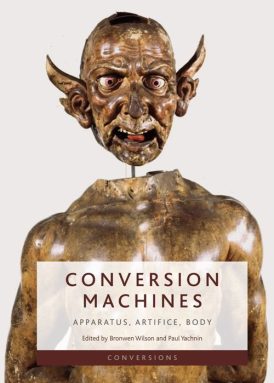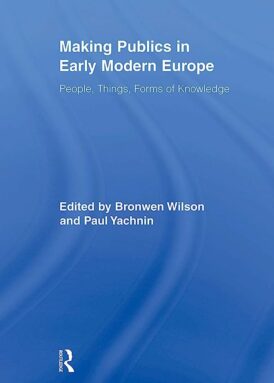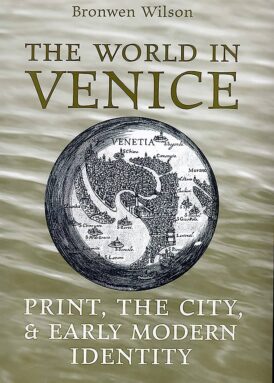Bronwen Wilson is the Edward W. Carter Chair in European Art and the Director of the Center for 17th– and 18th-Century Studies and William Andrews Clark Memorial Library at UCLA. Her research and teaching explore the artistic and urban cultures of early modern Europe (1300-1700), with a focus on space, print, portraiture, landscape, and transcultural, material and environmental interactions. Fellowships include Villa i Tatti in Florence, The Folger Shakespeare Library, The Newberry Library, The Bogliasco Foundation in Liguria, and the Social Sciences and Humanities Research Council of Canada.
The histories of Venetian art and European perceptions of the Ottoman Turks are important for several publications, including The World in Venice: Print, the City, and Early Modern Identity (winner of the Roland H. Bainton prize for Art History in 2006) and a recently-completed book project, Inscription and the Horizon in Early Modern Mediterranean Travel Imagery. This study brings to light the surprising range of diverse, often anomalous, formats into which itinerant artists converted their temporal experiences of journeying between European and Islamic worlds.
Another recently completed book project focuses on artistic engagement with the human face in Northern Italy at the end of the Renaissance. The Face of Uncertainty considers increasing doubt about the trustworthiness of countenances and accompanying artistic experimentation with physiognomy, conversation, blindness, animals, and death.
Wilson’s new book project, “Otherworldly Natures: the subterranean imminence of stone,” probes artistic engagement with quarries, riverbeds, and lithic formations in early modern painting. The study contributes to a new five-year research project, Making Green Worlds: Early Modern Art and Ecologies of Globalization, with Angela Vanhaelen. Together, they have co-edited three volumes, of which the most recent is Making Worlds: Global Invention in the Early Modern Period (University of Toronto Press, 2022).
Wilson has also co-edited two books, and collaborated with Paul Yachnin, most recently with Early Modern Conversions. They are the book series editors for that multidisciplinary research project, in which their own volume, Conversion Machines: apparatus, artifice, body (Edinburgh University Press, 2023), appears.
Education
Ph.D. Northwestern University, 1999
Research
CURRENT RESEARCH COLLABORATIONS AND INTERNATIONAL NETWORKS
- 2021 – 26: Making Green Worlds: Early Modern Art and Ecologies of Globalization (SSHRC)
- 2020 – 22: On the Sea and Coastal Ecologies: early modern pasts and uncertain futures (UCHRI)
- 2019 – current: Earth, Sea, Sky
- 2013 – current: École de Printemps/Réseau International pour la Formation à la Recherche en Histoire de l’Art
Books
-

- Conversion Machines: Apparatus, Artifice, Body
- Edinburgh University Press, 2023
-

- Making Worlds: Global Invention in the Early Modern Period
- University of Toronto Press, 2022
-

-

-

- The World in Venice: Print, the City, and Early Modern Identity
- University of Toronto Press, 2005
Courses
SELECTED COURSES TAUGHT, UNDERGRADUATE
- Making Worlds: Art, Materiality, and Early Modern Globalization (seminar): Explanatory narratives of colonialism, empire building, and religious conversion—of center, periphery, and globalization—have been under revision to nuance our understandings of what were immensely complex and multi-faceted phenomena. The seminar accordingly shifts the focus from governing regimes and institutions to ways in which creative forms and practices were intertwined in the dynamics of materiality and early modern globalism. Such a proposition directs analysis toward the flow of materials, artefacts, and motifs across borders and bodies of water. It attends to the experimentation that activated and responded to the circulation of people and things; and it investigates these interactions as constant, on-going processes.
- Ornament and Print (seminar): Ornament has often been sidelined in European art history. It has been defined as (merely) decoration, as devoid of meaning, as non-structural or non-functional, as supplemental, and as liminal. And yet, as this course posits, those characteristics of ornament yield insights about the mobility and agency of images, about processes of metamorphosis and transformation, and about imagination. Classes include visits to the Grunewald Center Collection at the Hammer Museum, the print-making studio at UCLA, and the Getty Center.
- Early Modern Venice, Space, and Cosmopolitanism (c.1450-1750) (seminar): The maritime city was a commercial hub, and immigrants were crucial to its economy. To accommodate Jews, Muslims, Greeks, and Protestants, among a wide range of ethnic groups, the Venetian state developed spaces to accommodate and to protect them, sites that also allowed for surveillance of their activities. This seminar focuses on these spaces, particularly scuole (confraternities), fondachi (residential warehouses), and the Jewish ghetto, together with their sculptural and painted decorations. We will also study their points of connection (bridges, walls, portals, waterways, calle [alleys] and campi [fields]) to the urban fabric and to the trading networks of the maritime state.
- Late Renaissance Art: Space, Vision, Conversion (lecture): Demands for art in Europe changed radically in the later sixteenth century in response to religious conflicts and accompanying debates about visual imagery. Art became a tool for competing religious orders, and for the papacy as it sought to assert global authority. In Northern Europe, reactions against religious imagery in the wake of the Reformation contributed to iconoclasm, but also to new forms, uses, and spaces for art, including vision, naturalism, markets, collecting, and new genres.
- Italian Renaissance Art and Culture (1400-1500) (lecture): With an emphasis on the body and space, this course explores ways in which painting, sculpture, and architecture participated in forging new social and political alliances in Florence and other centers on the peninsula.
- Italian Renaissance Art and Culture (1500-1600) (lecture): Explores the visual, material, and urban culture of Italy that was shaped by the increasingly authority of the courts, the discovery of worlds previously unknown to Europeans, the Reformation and Counter-Reformation, and the rising status of the artist.
- Visual Knowledge and Early Modern Globalization (1450-1650) (seminar): Studies the impact of an expanding image of the world on European artists and patrons by examining new artifacts and visual imagery (still lifes, kunstkammer objects, automata, illuminated books, travel imagery), representational practices (naturalism, drawing, metalwork, ceramics, cartography, print), and systems of classification (cabinets of curiosity, morphology, printed books).
- Visual Knowledge and Early Modern Globalization (1450-1650) (seminar): Studies the impact of an expanding image of the world on European artists and patrons by examining new artifacts and visual imagery (still lifes, kunstkammer objects, automata, illuminated books, travel imagery), representational practices (naturalism, drawing, metalwork, ceramics, cartography, print), and systems of classification (cabinets of curiosity, morphology, printed books).
- Portraiture and the Politics of the Face in Early Modern Europe (1450-1650) (seminar): Considers work by a wide range of artists from Albrecht Dürer to Sofonisba Anguissola, and from Bronzino to the Carracci, exploring themes such as self-portraiture and embodiment, realism, ethics, and anthropomorphic images.
SELECTED COURSES TAUGHT, GRADUATE
- Making Green Worlds: Early Modern Art and Ecologies of Globalization: This seminar engages with current debates about climate change that are at the forefront of public and academic discourse by re-assessing the intersections of global mobility, environmental change, and the creation of green worlds. The focus of the seminar will be on the role of visual imagery, built environments, and material artefacts that advance new understandings of the world as a human-made invention. We will take up questions raised by ecocritical approaches to art and art history while attending to power dynamics that occur in various modes of engagement with matter and materiality.
- The Sea: Liquidity, Mobility, Ingenuity: The recent turn to “blue humanities,” a term coined by Steven Mentz, and to “New Thalassology” (from the Greek for seas, thalassos), has focused attention on the complex interactions with and understandings of oceans, seas, and coastlines in the early modern period. This seminar explores visual and material forms and the insights they yield about maritime environments and their challenges. The emergence of seascapes and harbor scenes in genre paintings, the large number of shells in European cabinets of curiosities and grottos, ichthyology and fossils, maps and itineraries, ships and modes of navigation, horizons and coastlines, are some examples of the archive. Through readings and student research, we will contrast human and more-than-human centered viewpoints, interrogate narratives of progress and science, and contend with changing historical notions of nature and power.
- Early modern Landscape and Temporality: Taking the emergence of landscape as an independent genre during the sixteenth century as its point of departure, this seminar examines a wide range of images and media—maritime views, gardens, topographical imagery, anthropomorphic landscapes, lunar landscapes, mazes—alongside readings that probe our understandings of space and time.
- Early Modern Vision and Visuality: Interests in the possibilities and limits of vision come to the fore in the early modern period in response to encounters with unfamiliar specimens, experiments with perspective and lenses, witchcraft, and religious conflict. The seminar examines accompanying artistic engagement with modes of representation and new forms of visual imagery.
- The Face in the Image: portraits, embodiment, and faciality in early modern Europe: Examining the visual culture of the face and the body, the seminar inquires into the nature of portraiture and its terms of reference when the very meanings of identity were being redrawn.
- Things and Paths: Engaging with things and their movements prompts a reconsideration of concepts such as agency, migration, appropriation, resistance, translation, publics, and other ways in which things that matter gathered people together, or divided them. Focusing on the mobility of works of art and forms of knowledge in the early modern period, the seminar develops new ways of thinking about artifacts combined within a work (still life, genre painting), things arranged in places (collections, markets, museums), and things that move (sketchbooks, albums, processions).
- The Politics of Materiality and Matters of the Bio-political: Addresses both the material turn in cultural and visual studies, and also the role media, performativity, and psychoanalysis play in reconfiguring the manner in which the self and other biological forms are socially constructed, phantasmatically imagined, and physically represented.
